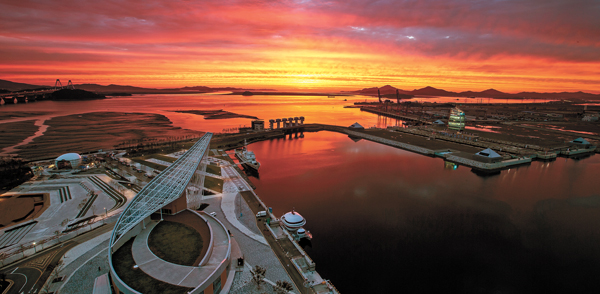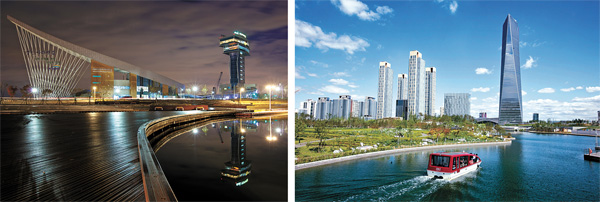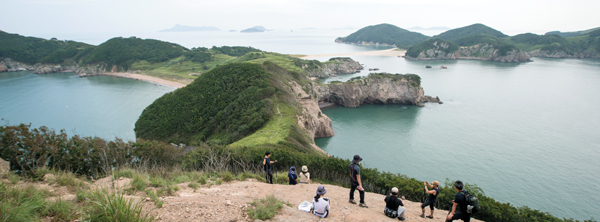[Sponsored Report] Incheon offers gateway into the culture of Korea

Gyeongin Ara Waterway as seen from the top floor of an observatory at Incheon International Airport.
With a massive harbor and a world-renowned international airport, Incheon serves as a transportation hub by air and sea. In 2003, it was designated as Korea’s first free economic zone, gathering investment from large local companies and global enterprises. However, the city is more than just a historically and economically significant place for Koreans. It is also developing into a cultural center, with many attractions that offer visitors a unique blend of the modern and traditional, the past and future.

Bordering the ocean, Incheon encompasses 168 islands, each offering a different take on the city’s natural beauty, history and culture. The islands and their charms make them the perfect getaways for visitors looking to rejuvenate themselves.
Wolmi Island: Incheon’s most iconic island, Wolmi Island represents 100 years of modern Korean history.
• Cultural Street: Wolmi Island’s Cultural Street is full of excitement all year round. Not only does it boast a theme park, cafés and a large collection of hoe, or raw fish, restaurants, it hosts a slew of interesting performances every weekend. A walk down the Chinsoo area, characterized by its bumpy rocks and small red lighthouse, gives visitors a full view of the sea. The view is particularly spectacular at sunset and at night, when the water reflects the light of the shops along the coast. To the back of the street is a collection of upscale cafés where visitors can enjoy a cup of coffee in the cool sea breeze.
• Wolmi Theme Park: Wolmi Theme Park is another of the island’s biggest attractions. Formerly known as My Land, it opened in September 1992 and has since become famous for being one of the filming locations for variety shows such as “We Got Married,” “Two Days and One Night” and “Running Man.” The park has various rides, the most popular of which are its 70-meter-high (230-foot-high) Hyper Shoot Drop, two-story Viking Ship and 115-meter-high Ferris wheel. It also houses a large indoor children’s playground complete with a miniature flume rides and boats. These facilities make the theme park enjoyable for visitors of all ages.
• Wolmi Park: Crafted from a former military base, Wolmi Park’s many attractions include a replica of a traditional palace garden, a museum on the history of Korean emigration and a 23-meter-tall hilltop observatory.
• Wolmi Observatory: At the top of Wolmi Observatory, visitors are treated to a panoramic view of Incheon, from the West Sea to its three international cities. The observatory is also home to a café where visitors can write messages for friends, family and lovers on “message blocks.” The square blocks full of good wishes are then displayed on the café’s glass walls.
• Wolmi Cultural Center: Located within the Wolmi Cultural Center is the Korean Food Experience Center, a place for visitors to try their hand at cooking Korean dishes using all-natural ingredients. The center’s special galleries, called the Traditional Life Exhibition and the Royal Court Exhibition, allow visitors to experience ancient Korean culture firsthand. There, visitors can wear hanbok, or traditional Korean clothing, and be photographed against the backdrop of their choice, be it a Korean wedding ceremony, a 60th birthday celebration or the King’s royal feast.
Seonjae Island: Named after the imagery of dancing fairies that descended from the sky, Seonjae Island boasts a beautiful coastline and view over the ocean. But what truly makes the island special are the two sandbar paths connecting it to the smaller satellite islands of Cheuk Island and Mok Island. Like gold carpets winding through silver waters, the pathways are only exposed twice a day when tide levels fall. This scenic view landed Seonjae Island on CNN’s list of 33 beautiful islands to visit in Korea.
Seungbong Island: Seungbong Island derives its name from its topography, which resembles a phoenix soaring through the sky. While the island is small enough to explore in half a day, its multi-colored coast, mysterious rocks and jungle-like recreational forest are awe-inspiring. Located along the southern coast of the island is Iille Beach, a white-sand beach 1,300 meters long and 40 meters wide. A dense forest stretches behind it, where visitors can relax in the shade.
Ganghwa Island: Having played an important role in Korean history from the prehistoric period onward, Ganghwa Island is full of cultural and historic sites, so much so that it is often referred to as one large history museum. Every year, visitors gather from all around to see its megalithic tombs, ancient palace sites, the famed Ganghwasanseong Fortress and royal Gyujanggak library. Its nature and food are other attractions that bring in tourists every year. The island prides itself on being an area with minimal pollution, producing rice, turnips, ginseng, sweet potatoes and pickled shrimp recognized nationwide for their quality.
Seokmo Island: A 10-minute ferry ride from Ganghwa Island brings you to the tiny island of Seokmo, whose main attraction is a temple hiding in the hills. Said to date back to the 7th century, Bomunsa Temple can be reached from the island’s main road, past a line of restaurants serving its famous crab stew among other seafood dishes. A steep slope lined with trees leads to a grotto built inside a natural cave, a reclining Buddha statue and a pagoda surrounded by statues of arkhat, disciples of the Buddha. Besides the usual attractions of a Buddhist temple, Bomunsa also boasts a view of the West Sea that is especially beautiful at sunset.
At Minmeoru Beach, the only beach on the island, vacationers and locals alike can enjoy hunting shellfish and frolicking in the mud once the tide goes out in the afternoon, turning the coastline into a giant mud flat.
Muui Island: Meaning “dancer’s dress,” Muui Island was given its name by fishers who claimed that on foggy days, it looks like the fluttering collar of a mounted general.
A must-do for visitors is a hike up Gusabong Peak (230 meters) and Mount Horyonggok (244 meters), the island’s highest point. Reminiscent of dancing fairies, the stunning view of the island on the walk down has earned it the name “sea route of wonder.”
Every summer, the island hosts Incheon’s most celebrated outdoor dance festival, where mask-clad performers and audiences spend the night dancing to music. Various styles of dance are represented, include belly dancing, salsa, the waltz, the tango, the cha-cha, modern jazz and traditional Korean folk dance.

Located 30 minutes from Incheon International Airport, Dongincheon is a refreshing change of pace from skyscraper-filled cities. It is instead an area where the past and present — as well as Korean and Chinese culture — coexists.
Chinatown: Incheon’s Chinatown came into being with the opening of Incheon Port in 1883, which made the area home to Chinese traders. The town has since grown into a major tourist attraction, drawing in visitors every weekend with its culinary delights, extravagant facades and historic murals.
It is the birthplace of jajangmyeon, a Chinese-Korean fusion dish of noodles in black bean sauce. More than 20 restaurants serving the popular dish are scattered around the area, attracting not only jajangmyeon enthusiasts but also tourists looking for a culinary adventure. The lantern-lined streets of Chinatown are also dotted with vendors selling street food such as gong-gal bread, a puffed-up snack, and hwaduk mandu, dumplings cooked in special braziers.
The town is often the filming location of Korean dramas, so visitors are advised to keep an eye out for their favorite celebrities.
Jayu Park: Jayu Park, which means “freedom” in Korean, was given its current name on October 1957 when a statue of General MacArthur, who led the Incheon Amphibious Landing Operation during the Korean War, was erected. The park has many small and large sculptures including The Centennial Monument, a towering structure built in 1982 to commemorate the 100th anniversary of amity between Korea and the United States.
Many places in the park offer spectacular views of downtown Incheon and its surrounding areas. But in spring, visitors flock to the park to see its cherry blossoms, which bloom later in the year than in most other regions due to its proximity to the West Sea.
Fairytale Village: Originally a dilapidated neighborhood, Fairytale Village was renovated by the Songwol-dong community to look like a collection of fairy tales brought to life. Repainted with vibrant colors, the old houses now depict characters and scenes from classic tales such as Red Riding Hood, Alice in Wonderland and the Wizard of Oz.
Fairytale Village is located only a few blocks west of Chinatown but can be just as easily reached from Incheon Station. Covered in vibrant colors and three-dimensional artwork, it is impossible to miss.
Shinpo Market: The history of Shinpo Market dates back to the 1890s, shortly after Incheon Port was forcefully opened to foreigners by the Japanese. The resulting trade opportunities led local merchants to set up stalls targeting incoming tradesmen and sailors.
While the market was only officially registered as one in 1970, it has long been famous for its dumplings, jjolmyeon, or chewy noodles, and dakgangjung, a kind of fried chicken covered in a spicy and sweet sauce. Some dakgangjung shops in Shinpo Market have become so popular that customers must stand in line for as much as half an hour for a taste.

Bibap: Called the world’s most delicious show, Bibap is a nonverbal performance based on bibimbap, a signature Korean dish made of rice, seasoned vegetables, fermented soybean paste and beef. Its actors mimic the sounds of making bibimbap with beat-boxing and acappella singing, and express the cooking process through dynamic dances, acrobatics and martial arts. Since its debut in 2009, Bibap has been well-received at food conferences and global venues such as the 2010 Edinburgh Festival Fringe. Today, it is heralded as the pioneer of a new form of entertainment dubbed “eatertainment.”
The performance is set in a kitchen, where we see chefs cooking a variety of dishes as orders roll in. After preparing Chinese, Japanese and Italian food, they receive an order for “the world’s best bibimbap,” which prompts the two rival sous chefs to compete in a bibimbap cook-off. Their dishes are judged by a randomly selected audience member who gets to determine who stays in the kitchen as the winner.
Songdo International City: With its sleek architecture and long straight roads, Songdo looks like a city from the future. However, it strikes the right balance between nature and urbanization with Central Park, a natural oasis in the city. The park is dotted with neofuturistic metal structures such as the Tri-Bowl, a cultural complex in the shape of three upturned shells. Built to commemorate the Global Fair & Festival held in Incheon in 2009, the building features an event hall, multi-purpose hall and digital library.
Another of Songdo’s unique attractions is the Compact Smart City, an exhibition center that allows visitors to explore Incheon’s past, present and future. Visitors can learn about the city’s humble beginnings in the center’s Ancient and Modern History exhibition hall, then move on to its 5D theater to watch a movie on its modernization. The movie integrates state-of-the-art effects using wind and water jets to make the experience more realistic and entertaining.
Gyeoungin Ara Waterway: Originally created to combat flooding in the Gulpo River region, Gyeoungin Ara Waterway was redesigned to serve as both a flood prevention facility and a transport route. The 18-kilometer-long waterway has connected the Han River and the Yellow Sea since its completion on May 25, 2012.
Visitors can board a cruise ship that will take them through the entire length of the waterway and its eight beautiful sites, the most scenic of which are the Ara Waterfall and Duri Ecological Park. The area is also a great biking destination, with a 41.3km-long bicycle path that runs along its banks, complete with stations where visitors can rent and return bicycles at different points in their journey.
The waterway also hosts marathons, bike festivals and boat races for sports enthusiasts looking to enjoy the outdoors.

Hikers on Mount Yeonpyeong look down upon the rocky coast of Gulup Island, one of Incheon’s 168 unique treasures.










with the Korea JoongAng Daily
To write comments, please log in to one of the accounts.
Standards Board Policy (0/250자)